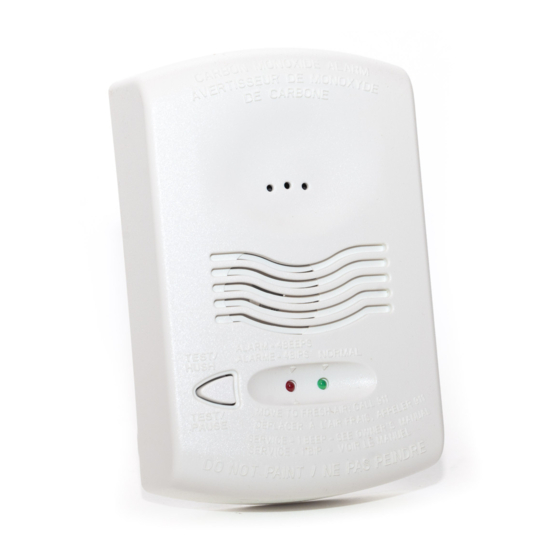
Table of Contents
Advertisement
Quick Links
What is carbon monoxide?
Carbon monoxide (CO) is an odorless, colorless, tasteless
and highly toxic gas. It is produced when flame-fueled
devices, such as heating systems, power tools, grills and
ovens, malfunction or are not properly vented.
What happens if CO is inhaled?
The CO is absorbed into the bloodstream, replacing the
oxygen traveling to vital organs throughout the body.
Depending on the concentration of CO in the air and the
length of exposure, effects can include a mild headache,
drowsiness, nausea, dizziness, unconsciousness and suffo-
cation. CO poisoning can occur with small amounts accu-
mulating in the bloodstream over time, or large amounts
being inhaled quickly.
How do CO detectors protect residents
from CO poisoning?
CO detectors protect residents by monitoring the air and
measuring the amount of CO present over a time interval.
When dangerous levels are calculated, CO detectors flash
and sound a temp-4 alarm.
Where should a CO detector be
installed?
Ideally, a CO detector should be installed:
• Within 10 feet of all sleeping areas
• Inside the bedroom if it contains a fuel burning appli-
ance
• On every floor of the building
• In any room that contains a fuel burning appliance
Where should a CO detector not be
installed?
Ideally, a CO detector should not be installed:
• Within 10 feet of any cooking appliance
• Directly above a sink, cooker, stove or oven
• Next to a door or window that would be affected by
drafts (i.e. extractor fan or air vent)
• Outside
• In any environment that does not comply with the detec-
tor's environmental specifications
• In or below a cupboard
• Where air flow would be obstructed by curtains or fur-
niture
• Where dirt or dust could collect and block the sensor
• Where it could be knocked, damaged or inadvertently
removed
What are the benefits of a monitored CO
detector?
CO detectors can be connected to the initiating circuit of a
control panel that connects to a central station. Supervised
detectors provide peace of mind by adding an extra level of
CO1224A Carbon Monoxide Detector with RealTest
Frequently Asked Questions
protection for situations in which residents cannot respond
to an unsupervised alarm, such as when residents are sleep-
ing, when the home is empty, or when residents are already
suffering from the effects of CO. If the CO concentration
hits a dangerous level, the homeowner will not only be
notified by the detector and the control panel, but also by
the central station. If the owner is unreachable, the central
station may send the proper authorities to investigate.
Central station procedures may vary.
Are CO detectors required by law?
Many provinces and municipalities require CO detectors.
Check with the local Authority Having Jurisdiction for CO
detector requirements in your area.
What is the System Sensor CO1224A CO detector?
The CO1224A detector is a 4-wire, electrochemical carbon
monoxide detector that works with both 12- and 24-volt fire
and security panels and has central station monitoring capa-
bilities. It is the first CO detector to include a test feature that
verifies CO cell functionality.
How do electrochemical detectors
compare with other detectors?
Electrochemical detectors are the newest, most refined CO
detectors available. They take the most accurate readings
of CO concentrations, from low levels of CO that may be
hazardous over long periods of time to high concentrations
that present an immediate danger.
What is the life span of the CO1224A CO detector?
The electrochemical sensor operates at full strength for
approximately six years. Its built-in timer will signal when the
detector needs to be replaced.
w w w . s y s t e m s e n s o r . c a
™
continued on other side
©2008 System Sensor. A05-0404-001
Advertisement
Table of Contents

Summary of Contents for System Sensor CO1224A
- Page 1 • On every floor of the building What is the life span of the CO1224A CO detector? • In any room that contains a fuel burning appliance The electrochemical sensor operates at full strength for Where should a CO detector not be approximately six years.
- Page 2 How should the CO1224A unit be wired to a fire or security Does the RealTest feature take a lot of time? control panel? No. The RealTest feature on the CO1224A allows the installer Per NFPA 720, CO detectors must be wired on a non-fire to easily test the detector in less than one minute.



Need help?
Do you have a question about the CO1224A and is the answer not in the manual?
Questions and answers